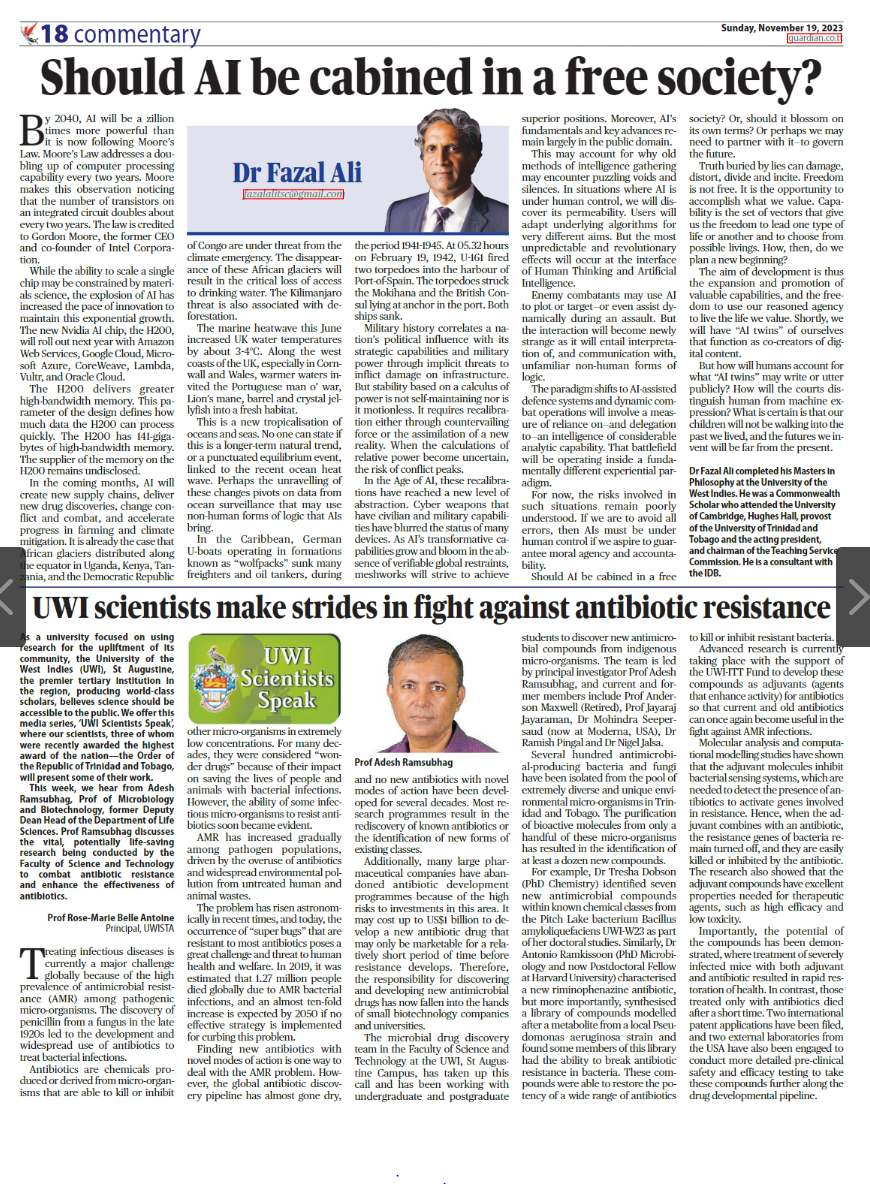UWI scientists make strides in fight against antibiotic resistance
By Prof Adesh Ramsubhag
As a university focused on using research for the
upliftment of its community, the University of
the West Indies (UWI), St Augustine, the premier
tertiary institution in the region, producing
world-class scholars, believes science should be
accessible to the public. We offer this media
series, ‘UWI Scientists Speak’, where our
scientists, three of whom were recently awarded
the highest award of the nation—the Order of the
Republic of Trinidad and Tobago, will present
some of their work.
This week, we hear from Adesh Ramsubhag, Prof
of Microbiology and Biotechnology, former
Deputy Dean Head of the Department of Life
Sciences. Prof Ramsubhag discusses the vital,
potentially life-saving research being conducted
by the Faculty of Science and Technology to
combat antibiotic resistance and enhance the
effectiveness of antibiotics.
Prof Rose-Marie Belle Antoine Principal, UWISTA
Treating infectious diseases is currently a major
challenge globally because of the high prevalence
of antimicrobial resistance (AMR) among
pathogenic micro-organisms. The discovery of
penicillin from a fungus in the late 1920s led to
the development and widespread use of
antibiotics to treat bacterial infections.
Antibiotics are chemicals produced or derived
from micro-organisms that are able to kill or
inhibit other micro-organisms in extremely low
concentrations. For many decades, they were
considered “wonder drugs” because of their
impact on saving the lives of people and animals
with bacterial infections.
However, the ability of some infectious microorganisms to resist antibiotics soon became
evident.
AMR has increased gradually among pathogen
populations, driven by the overuse of antibiotics
and widespread environmental pollution from
untreated human and animal wastes.
The problem has risen astronomically in recent
times, and today, the occurrence of “super bugs”
that are resistant to most antibiotics poses a
great challenge and threat to human health and
welfare. In 2019, it was estimated that 1.27
million people died globally due to AMR bacterial
infections, and an almost ten-fold increase is
expected by 2050 if no effective strategy is
implemented for curbing this problem.
Finding new antibiotics with novel modes of
action is one way to deal with the AMR problem.
However, the global antibiotic discovery pipeline
has almost gone dry, and no new antibiotics with
novel modes of action have been developed for
several decades. Most research programmes
result in the rediscovery of known antibiotics or
the identification of new forms of existing
classes.
Additionally, many large pharmaceutical
companies have abandoned antibiotic
development programmes because of the high
risks to investments in this area. It may cost up
to US$1 billion to develop a new antibiotic drug
that may only be marketable for a relatively short
period of time before resistance develops.
Therefore, the responsibility for discovering and
developing new antimicrobial drugs has now
fallen into the hands of small biotechnology
companies and universities.
The microbial drug discovery team in the Faculty
of Science and Technology at the UWI, St
Augustine Campus, has taken up this call and has
been working with undergraduate and
postgraduate students to discover new
antimicrobial compounds from indigenous
micro-organisms. The team is led by principal
investigator Prof Adesh Ramsubhag, and current
and former members include Prof Anderson
Maxwell (Retired), Prof Jayaraj Jayaraman, Dr
Mohindra Seepersaud (now at Moderna, USA), Dr
Ramish Pingal and Dr Nigel Jalsa.
Several hundred antimicrobial-producing
bacteria and fungi have been isolated from the
pool of extremely diverse and unique
environmental micro-organisms in Trinidad and
Tobago. The purification of bioactive molecules
from only a handful of these micro-organisms
has resulted in the identification of at least a
dozen new compounds.
For example, Dr Tresha Dobson (PhD Chemistry)
identified seven new antimicrobial compounds
within known chemical classes from the Pitch
Lake bacterium Bacillus amyloliquefaciens UWIW23 as part of her doctoral studies. Similarly, Dr
Antonio Ramkissoon (PhD Microbiology and now
Postdoctoral Fellow at Harvard University)
characterised a new riminophenazine antibiotic,
but more importantly, synthesised a library of
compounds modelled after a metabolite from a
local Pseudomonas aeruginosa strain and found
some members of this library had the ability to
break antibiotic resistance in bacteria. These
compounds were able to restore the potency of a
wide range of antibiotics to kill or inhibit
resistant bacteria.
Advanced research is currently taking place with
the support of the UWI-ITT Fund to develop
these compounds as adjuvants (agents that
enhance activity) for antibiotics so that current
and old antibiotics can once again become useful
in the fight against AMR infections.
Molecular analysis and computational modelling
studies have shown that the adjuvant molecules
inhibit bacterial sensing systems, which are
needed to detect the presence of antibiotics to
activate genes involved in resistance. Hence,
when the adjuvant combines with an antibiotic,
the resistance genes of bacteria remain turned
off, and they are easily killed or inhibited by the
antibiotic.
The research also showed that the adjuvant
compounds have excellent properties needed for
therapeutic agents, such as high efficacy and low
toxicity.
Importantly, the potential of the compounds has
been demonstrated, where treatment of severely
infected mice with both adjuvant and antibiotic
resulted in rapid restoration of health. In
contrast, those treated only with antibiotics died
after a short time. Two international patent
applications have been filed, and two external
laboratories from the USA have also been
engaged to conduct more detailed pre-clinical
safety and efficacy testing to take these
compounds further along the drug
developmental pipeline.

